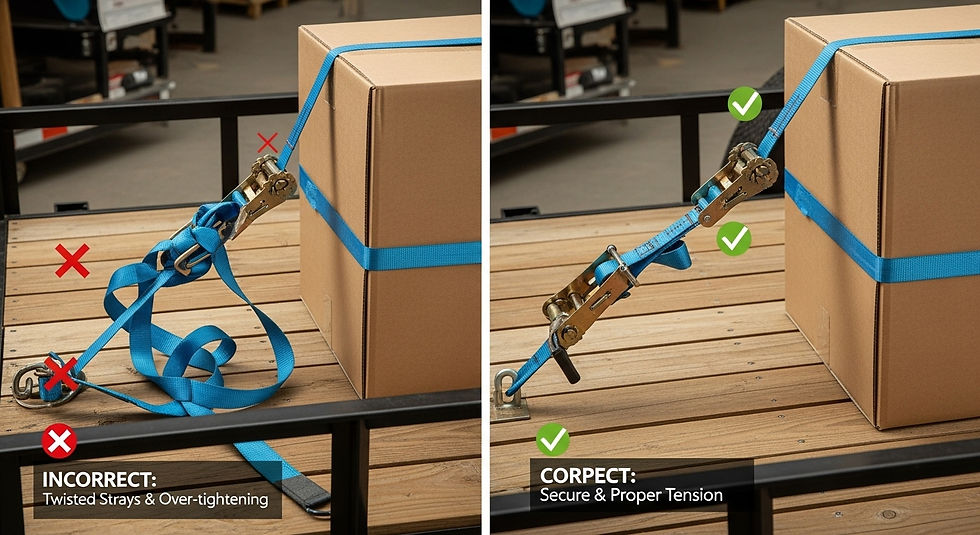How to Properly Use Ratchet Tie Down Straps on a Trailer
- Mark Smith

- Oct 10
- 4 min read
Whether you're a shop owner transporting goods, a contractor hauling equipment, or a weekend adventurer with an ATV, the safety of your load—and everyone else on the road—depends on how well it's tied down. This is why knowing how to properly use ratchet straps is a non-negotiable skill. A loose strap can lead to shifting cargo, property damage, or worse. For business owners, an incident on the road can damage your reputation and your bottom line, which is why sourcing reliable tie-downs is a top priority. This guide will walk you through the correct way to use these essential tools, ensuring every haul is safe and secure.

Choosing the Right Ratchet Strap for Your Trailer
Before you even think about tightening a strap, you need to make sure you have the right one. Not all ratchet straps are created equal, and using one that's underrated for your cargo is a common and dangerous mistake.
Here’s what to look for:
Working Load Limit (WLL): This is the most crucial factor. The WLL indicates the maximum weight a strap is designed to safely handle. Always check the tag on the strap. The combined WLL of all your straps should be at least 50% of the total weight of your cargo. When in doubt, it's always better to use a strap with a higher WLL than you think you need.
Strap Width and Length: Wider straps generally have a higher WLL. Choose a length that allows you to comfortably loop around your cargo and connect to anchor points without too much excess webbing, which can be a hassle to manage.
Hardware: Check the end fittings. Do you need flat hooks, J-hooks, or wire hooks to connect to your trailer’s anchor points? High-quality components, like those found on dependable USA ratchet straps, ensure a stronger, more reliable connection.
A Step-by-Step Guide: How to Use Ratchet Straps
Using a ratchet strap might seem intimidating at first, but the mechanism is straightforward once you understand it. Follow these steps for a secure tie-down every time.
Step 1: Threading the Strap
Open the Ratchet: Pull the release catch on the ratchet handle to fully open it.
Feed the Webbing: Take the loose end of the strap and thread it through the slot in the center rotating spool (the mandrel) of the closed ratchet.
Pull the Slack: Pull the webbing through until the strap is snug against your cargo. You want to remove as much slack as possible by hand before you start ratcheting. This will reduce the number of times you need to crank the handle.
Step 2: Tightening Your Ratchet Straps
Crank the Handle: Begin cranking the ratchet handle up and down. You will hear a clicking sound as the spool turns and tightens the webbing.
Check Tension: Continue ratcheting until the strap is taut. A properly tightened strap should be firm to the touch with very little give. Be careful not to overtighten, as this can damage your cargo or the strap itself. A good rule is to stop once you feel significant resistance.
Step 3: Locking and Securing the Strap
Close the Handle: Once the desired tension is reached, close the ratchet handle completely until it is flat and locked in place. This prevents the strap from loosening during transit.
Tie Off the Excess: Neatly tie up the leftover webbing. A loose end flapping in the wind can get caught in wheels, fray, or come undone. You can tie it in a simple knot, use a rubber band, or wrap it around the locked ratchet.
How to Release a Ratchet Strap
Releasing the tension is the reverse of tightening.
Pull the Release Catch: Pull and hold the release tab or lever on the top of the ratchet assembly.
Open the Handle: While holding the release, open the ratchet handle all the way until it is flat (180 degrees). This will instantly release the tension on the spool.
Pull the Strap Free: With the tension gone, you can easily pull the webbing out from the spool.
Avoiding Common Mistakes with Ratchet Straps
Many cargo accidents happen due to simple, avoidable errors. Here are some common mistakes to watch out for:
Using Damaged Straps: Before every use, inspect your straps for frays, cuts, or sun damage. Never use a compromised ratchet strap. Reputable suppliers like Asquare Parts Inc. emphasize quality because they know durability is directly linked to safety.
Ignoring the WLL: As mentioned earlier, never exceed the Working Load Limit. It’s there for a reason.
Improper Angles: Straps are strongest when they pull in a straight line. The ideal angle for tie-downs is between 30 and 60 degrees from the trailer bed.
Not Protecting Your Cargo: If a strap goes over a sharp edge, use an edge protector or a piece of cardboard to prevent it from cutting into the webbing.

For added convenience, some users prefer retractable ratchet straps, which automatically manage the excess webbing, making the process quicker and cleaner.
By following these guidelines, you can confidently secure any load. Proper use of ratchet straps is not just about protecting your cargo—it’s about ensuring safety for yourself and everyone you share the road with. Always double-check your connections before you drive off, and take the time to do it right.




Comments